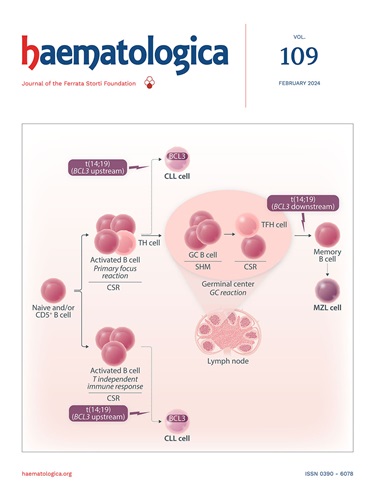Hepatitis E virus infections in people with multiple myeloma: an emerging challenge in the era of immunotherapeutic approaches.
IF 7.9
1区 医学
Q1 HEMATOLOGY
引用次数: 0
Abstract
Hepatitis E virus (HEV) is an under-recognized cause of viral hepatitis, with rising incidence in high-income countries largely driven by zoonotic transmission. Patients with multiple myeloma (MM) are especially vulnerable to HEV, yet recommendations for antiviral treatment and impact on the management of myeloma treatment are missing. Here, we describe seven patients (five males, two females) with MM who were diagnosed with HEV infection at a tertiary care center in Western Europe within less than one year. All cases were confirmed by positive HEV RNA PCR in peripheral blood. Although no instances of fulminant hepatitis were observed, HEV prompted clinically relevant interruptions: autologous stem cell transplantation was postponed, lymphocyte apheresis for CAR T-cell manufacturing was delayed, and bispecific antibody regimens were suspended for up to five months. Ribavirin was initiated in four cases. The three patients undergoing T-cell-redirecting therapies, including one with prior ciltacabtagene autoleucel and two on bispecific antibodies, progressed to chronic infection despite ribavirin treatment. One patient, despite clearing HEV from peripheral blood, developed persistent vertigo and tested positive for HEV RNA in cerebrospinal fluid, indicating neuroinvasion. As the largest reported cohort of MM patients with HEV infections and the first to document chronic infection during treatment with T-cell-redirecting therapies, this study emphasizes the urgent need to increase awareness of HEV as an emerging threat, refine screening protocols at baseline or during unexplained aminotransferase flares, and to establish standardized therapeutic strategies in the era of novel immunotherapeutic approaches.多发性骨髓瘤患者的戊型肝炎病毒感染:免疫治疗方法时代的新挑战。
戊型肝炎病毒(HEV)是一种未得到充分认识的病毒性肝炎病因,高收入国家的发病率不断上升,主要是由人畜共患传播引起的。多发性骨髓瘤(MM)患者特别容易感染HEV,但关于抗病毒治疗的建议和对骨髓瘤治疗管理的影响尚不清楚。在这里,我们描述了7名MM患者(5名男性,2名女性),他们在不到一年的时间里在西欧的一个三级保健中心被诊断为HEV感染。所有病例外周血均检测HEV RNA PCR阳性。虽然没有观察到暴发性肝炎的病例,但HEV引起了临床相关的中断:自体干细胞移植被推迟,用于CAR - t细胞制造的淋巴细胞分离被推迟,双特异性抗体方案被暂停长达5个月。在4例病例中开始使用利巴韦林。三名接受t细胞重定向治疗的患者,包括一名先前使用西他卡他烯自甲苯的患者和两名使用双特异性抗体的患者,尽管接受利巴韦林治疗,但仍进展为慢性感染。一名患者尽管清除了外周血中的HEV,但仍出现了持续性眩晕,脑脊液中HEV RNA检测呈阳性,表明神经侵犯。作为报道的最大的MM患者HEV感染队列,以及首次记录在t细胞重定向治疗期间慢性感染的研究,该研究强调迫切需要提高对HEV作为一种新兴威胁的认识,完善基线或不明原因转氨酶发作期间的筛查方案,并在新的免疫治疗方法时代建立标准化的治疗策略。
本文章由计算机程序翻译,如有差异,请以英文原文为准。
求助全文
约1分钟内获得全文
求助全文
来源期刊

Haematologica
医学-血液学
CiteScore
14.10
自引率
2.00%
发文量
349
审稿时长
3-6 weeks
期刊介绍:
Haematologica is a journal that publishes articles within the broad field of hematology. It reports on novel findings in basic, clinical, and translational research.
Scope:
The scope of the journal includes reporting novel research results that:
Have a significant impact on understanding normal hematology or the development of hematological diseases.
Are likely to bring important changes to the diagnosis or treatment of hematological diseases.
 求助内容:
求助内容: 应助结果提醒方式:
应助结果提醒方式:


